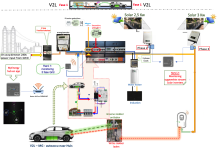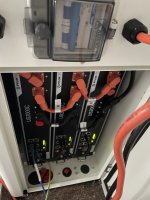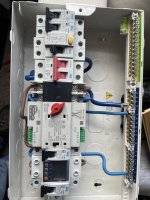Purclewan
Established Member
If you place an electrode in the ground and electricity is passed into that electrode during a fault it creates an Earth potential rise (EPR) in the ground, if there is another electrode within the EPR/earth zone for that electrode, some of that fault current will travel through that electrode and associated cable connected.
The DNO earthing system is referred to as a global earthing system when in a built up area, essentially the amount of copper in the ground the DNO has is that great that you cannot escape it, so when you island and you don't have a correctly designed earth unless you are in the middle of nowhere and a considerable distance from a DNO substation, you will also be within the Earthing zone of the DNO.
And if part of that network is being worked on your single rod and fault could endanger anyone working on the DNO network as an unintentional back feed.
Edit: that's why you have to make sure you have enough copper in the ground and a correctly undertaken earthing study to ensure that next to no fault current goes into the DNO earthing system by making yours the path of least resistance, this is again only applicable when islanding this is why loss of mains is mandatory on G98/99 inverters so they can't island.
Thanks Ayoull,Your connection to the DNO network has to be compliant with the Electricity Safety, Quality and Continuity Regulations (ESQCR), part of that places an obligation on the end user to not breach the requirements of those regulations through there actions or inactions.
If you are completely off grid you have a legal obligation to not cause harm to anyone else through your actions or inactions.
As the DNO is there already incumbent you have to ensure you don't cause injury or damage to any person, property or livestock through what you do or don't.
As someone who is exploring off-grid and grid backup systems for my own use, I suppose what I am getting at is the difficulty in getting a comprehensive and straight answer to earthing issues surrounding particularly this subject.
Although I have worked in the computer industry for the last 30 years I did qualify as an Electronics engineer, keep myself abreast of new developments and think I have a pretty good understanding of electrical systems. However, despite reading widely and studying all the relevant regs I can find, nothing I see is clear cut and in fact in many instances can seem downright contradictory. It all seems to depend on who is doing the reading.
What seems to be the case is that once again Technology is running ahead of regulation. I want to ensure my installation is safe but getting straight answers is proving difficult with plenty of reasons why I can't do something but few practical suggestions on how I can. In fact typically what I read on the IET forums (for example) is several people (all engineers) will give several different opinions on the same earthing problem and quote different regs. All highly confusing.
What does seem to be a common thread are "real-world situations" and "common sense".



